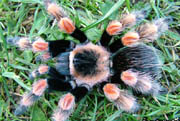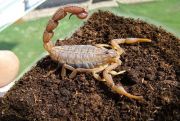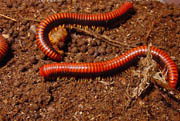Welcome in my tarantula world

 Gallery of tarantulas |
 Gallery of mating tarantulas |
 Gallery of scorpions |
 Gallery of millipedes |
Tarantula care
Tarantulas are spiders belonging to the family Theraphosidae. They are characterized by having tarsi (feet) with two claws and claw tufts.Tarantulas can be kept as house pets. A terrarium with an inch or two of damp vermiculite or a mixture of soil and sphagnum moss (but not with cedar shavings as they are toxic to many spiders) on bottom provides an ideal habitat. (Burrowing tarantulas will require a much deeper layer.) Tarantulas can be fed a variety of living animals (insects, small mice, small fish in the water bowl, and reptiles are on their menu).
The true tarantula
The true tarantulas are all spiders of the family Theraphosidae, sometimes called bird spiders or monkey spiders. Related families include the funnel-web spiders and the trap door spiders, which sometimes also get called tarantulas. The family Theraphosidae includes over 300 different species of tarantulas, divided over 12 subfamilies (formerly 13). Tarantulas are excellent climbers.Tarantulas are long-legged, long-living spiders, whose entire body is covered with short hairs. Tarantulas inhabit tropical to temperate regions in South America and Central America, Mexico, and the southwestern United States, Asia, Southern Europe, Africa and the Middle East.
Despite their often scary appearance and reputation, none of the true tarantulas make the list of deadly spiders (spiders having a strong toxin, dangerous to humans), and this particular kind of tarantula is regarded as being especially docile. Some people claim that there are deadly varieties of tarantulas somewhere in South America. This claim is often made without identifying a particular spider although the "banana tarantula" is sometimes named. The dangerous Brazilian wandering spider (Phoneutria nigriventer) is probably the spider in question as it sometimes found hiding in clusters of bananas and is one of several spiders called the "banana spider". It is not a tarantula but it is fairly large (about an inch long), somewhat hairy, and is regarded as aggressive. However, the Sydney funnel-web spider (Atrax robustus), is perhaps the spider in the world that is the most highly aggressive, highly venomous, and likely to bite repeatedly and envenomate enthusiastically. It is a species of the venomous funnel-web tarantulas, a member of the same Suborder as the true tarantulas but not one of the Theraphosidae.
Size, color and type
Depending on the species, their body length may vary from 1-3 inches (2.5 - 7.5 cm), with 3 to 5 inch (8-12 cm) leg spans (their size when including their legs). Some species are said to be even larger and to have 10-inch leg spans. On the average, tarantulas weigh from 2 to 3 ounces (60-90 grams). The Goliath birdeater (Theraphosa blondi) is generally regarded to be the largest species, however some breeders and hobbyists believe otherwise. The Pinkfoot goliath tarantula (Theraphosa apophysis) was described 187 years after the goliath birdeater; therefore it is not as well-known. However legspans of up to 13 inches have been reported.The majority of tarantulas are brown or black, however some species have more extensive color schemes, ranging from cobalt blue (cobalt blue tarantula, Haplopelma lividum), black with white stripes (pink zebra beauty or Eupalaestrus campestratus and Brazilian giant white knee tarantula or Acanthoscurria geniculata) to metallic blue legs with vibrant orange abdomen (greenbottle blue tarantula, Chromatopelma cyaneopubescens). Their natural habitats include savanna, grasslands such as the pampas, rainforests, deserts, scrubland, mountains and cloud forests. They are generally divided into terrestrial types (that frequently make burrows) and arboreal types.
Many tarantula species exhibit pronounced sexual dimorphism. Males tend to be smaller (especially the abdomen) and more drably colored. Males also tend to have shorter lifespans. For these reasons, most tarantulas kept as pets are female.
Read more about tarantulas in wikipedia.


Banner code: <a href="http://www.spidy.goliathus.com/english/" title="Tarantulas, tarantula care"><img src="http://www.spidy.goliathus.com/english/banner.gif" style="width: 468px; height: 60px; border: 1px solid #000000" alt="Tarantula care"></a>
